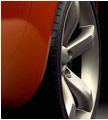For Release: August 28, 2001
Contact:
Charles Licari, GM
810-986-0077
charles.licari@gm.com
Marv Gellman, Gellman Public Relations
248-244-9433
mgellman@gellmanpr.com
Michelle Talmo, Basell
302-996-6073
michelle.talmo@basell.com
WARREN, MICH. - An advanced thermoplastic olefin (TPO) nanocomposite part is being used on 2002 GM mid-size vans, in the first automotive exterior application of this lightweight, high performance and affordable material, General Motors and partners Basell, Southern Clay Products and Blackhawk Automotive Plastics announced today.
GM and the three suppliers have played key roles in making a TPO-based nanocomposite step-assist for 2002 GMC Safari and Chevrolet Astro vans that assists occupants in stepping into and out of the vehicle. The vans are produced by GM at its Baltimore Assembly Plant and the step-assist is a dealer-installed option.
Nanocomposites are stiffer, lighter and less brittle in cold temperatures. They will also be more recyclable because there is less additive material in the plastic mix.
On a volume basis, parts made of nanocomposites cost about as much as conventional TPOs because less material is needed to manufacture them. Also, no new tooling is required to mold these parts. GM and Basell expect the price to improve as nanocomposites find their way into more parts.
"Although the step-assist is a simple, low-volume part, we see this as a significant and exciting first step that opens the door to increased use of TPO-based nanocomposites in future vehicles," said Alan I. Taub, executive director of science for GM Research and Development.
Partner Strategy - This innovative material is the product of advanced scientific research at the GM R&D Center in Warren, Mich. and an exclusive GM development agreement with Basell, the world's largest producer of polypropylene resins for plastics; and Southern Clay Products, Inc. of Gonzales, Texas, which mines and processes the ultrapure "smectite" clay additive. The step-assist parts are molded by Blackhawk Automotive Plastics, Inc. of Mason, Ohio.
"This is an excellent example of our partnering strategy," said Taub. "We believe partnerships are the fastest way to bring innovative technology to the marketplace. Just about two and a half years ago, GM and Basell (then Montell) announced joint development of a new family of thermoplastic olefins for exterior and interior applications."
"R&D best describes the roles that GM and Basell played in the commercialization of the step-assist," said William J. Windscheif, global business vice president, Advanced Polyolefins, Basell. "GM represents the 'research' in R&D, and Basell, the 'development.' As GM successfully created the chemistry necessary to achieve all the positive attributes the nanocomposite material brings to the step-assist, Basell developed the technology necessary to industrialize the new material within Basell's manufacturing facilities."
Basell's manufacturing expertise was demonstrated as the company, working with GM and its partners, maximized the benefits of clay exfoliation in the new TPO composition, according to Windscheif.
Clay Additive - Like other thermoplastics, nanocomposites are made by introducing a solid material into a plastic resin to give it added strength and other positive properties. What's significant about these new plastics is that the particles being added are extremely small, only one-millionth of a millimeter thick. In comparison, the filler in conventional thermoplastic olefins, on average, are one thousand times thicker.
The process of adding inorganic fillers to polymers is actually an old idea, like making bricks with straw in them. The fibrous straw additive makes the brick more resistant to forces that would otherwise crack it.
"In the case of these materials, the additive is tiny flakes of a clay material which are only a nanometer (one-millionth of a millimeter) thick," Taub explained. "They have huge surface areas relative to the other additives we use, like talc, and the result is exceptional improvements in the properties of the plastics with only a fraction of the inorganic filler."
A TPO with as little as 2.5 percent inorganic nano filler is as stiff and much lighter than parts with 10 times the amount of conventional talc filler. The weight savings can reach 20 percent depending on the part and the material that is being replaced by the TPO nanocomposite.
Breakthrough Technology - GM's breakthrough has been to devise a way to peel apart the very thin flakes of the clay, like separating pages in a book. "The greater the extent of exfoliation, the thinner the particles are, and a greater surface area is available for interaction with the polymer matrix, resulting in better performance," Taub said.
GM, Basell and Southern Clay have an agreement that grants mutual confidentiality, which is unprecedented in GM's relationship with outside suppliers. Basell has also been granted an exclusive license on GM's process to manufacture the material. "That makes our research investment - which has been substantial - a much safer bet," Windscheif said.
General Motors (NYSE:GM), the world's largest vehicle manufacturer, designs, builds and markets cars and trucks worldwide. In 2000, GM earned $5 billion on sales of $183 billion. For more information about GM, visit www.GM.com.
Basell is a global leader in the production, marketing and sale of polyolefins, advanced materials and related products, and is the world's largest producer of polypropylene. The company has facilities in 22 countries and sales in more than 120 countries. Basell's Automotive Technology and Development Center in Lansing, Mich., is the premier supplier of polyolefin-based technologies to the global automotive market. For more information about Basell, visit
www.Basell.com.




